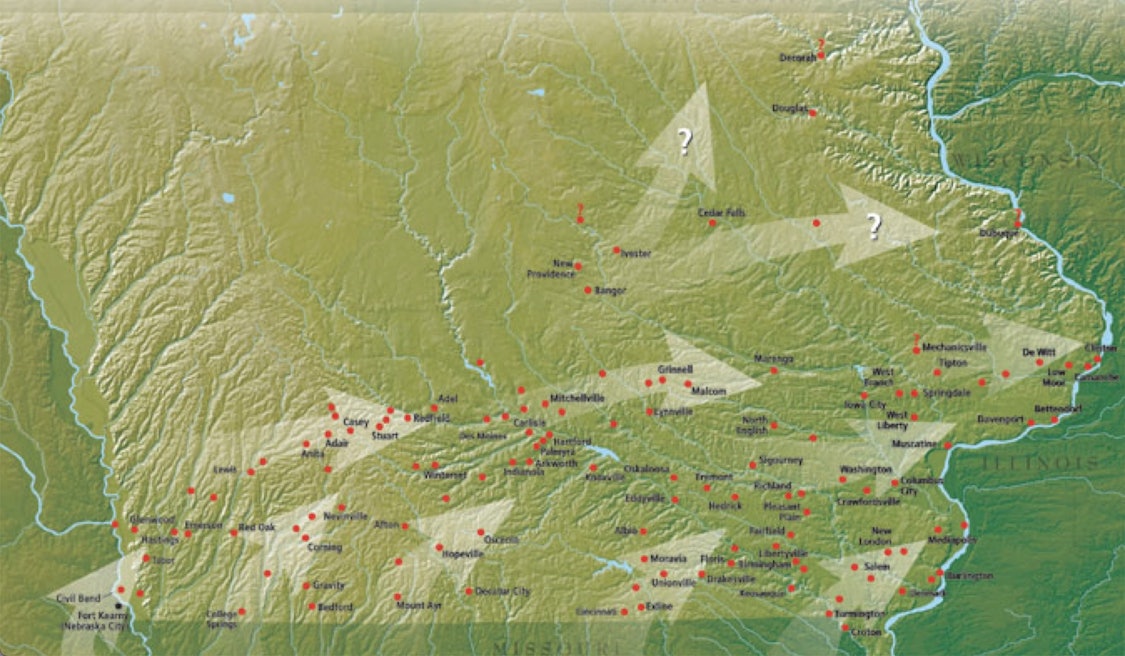
This column by Daniel G. Clark about Alexander Clark (1826-1891) first appeared in the Muscatine Journal on August 2, 2023. Above: Underground Railroad map by State Historical Society of Iowa.
It’s okay to imagine Muscatine as a station on the Underground Railroad, but only two reliable accounts tell specific instances of aid to the freedom seekers.
I’ve told about the 1848 Jim White case that is an important piece of the story of our hometown hero Alexander Clark. The second documented case is from the small town of Atalissa, along U.S. Highway 6 in the northern part of the county. Evidently slave catchers found no welcome there.
I fear the place is best known as the setting of a story about some workers in the turkey processing industry. That sad story from recent history is told in the documentary film “The Men of Atalissa” and the book The Boys in the Bunkhouse: Servitude and Salvation in the Heartland.
But let’s jump back to April 8, 1896, when John A. Jelly writes from Muscatine to an Ohio professor who is documenting memories of the boldly illegal, often-dangerous, mostly clandestine Underground Railroad. It’s almost too late for first-hand interviews, but Dr. Siebert and fellow researchers are collecting whatever stories can be found and assembling an archive of thousands of documents.
“I was intimately acquainted with one case of negro escape to Canada. It was in ’55. The Colored Man came from Missouri, came to Dr. Van Pelt’s Place and was kept in a cornfield for six weeks. The master soon was on the track of his man and asked Mrs. Van Pelt if she had seen such a [N-word]. She answered ‘I wouldn’t tell thee if I had.’ At the same time the master stuck an advertisement in the gate post offering $1500 reward for his capture.”
The county census of 1856 shows A.M. Van Pelt, age 44, physician, and wife Ann, 41; he born in Virginia, she in Ohio. Their four children were born in Ohio. I haven’t researched the family, but Ann’s use of “thee” suggests she, at least, was likely a Quaker.
When John Jelly claims “intimate” knowledge of what happened in 1855, he names several neighbors but does not say if he took part himself. In 1860 he married a Van Pelt daughter, Ellen, who was 11 or 12 in 1855.
Along with a half dozen Atalissa men, he names others researchers might contact at West Liberty and in Cedar County, implying their knowledge if not participation.
“Several of these men were intimate with the famous John Brown, and it is said know a great deal more than they tell about the underground road and I don’t.”
Scholars still rely on Jelly’s list. More can be learned about the people he named. All white people.
Back to the freedom seeker in the corn field.
“The colored man who carried his food lives in the city of Muscatine. His name is Wm. Greening.”
For about a dozen years I wondered about those words. Readers of the Jelly letter asked me about the Muscatine man who carried the food. Surely one of Alexander Clark’s associates, I said. They all knew each other, I said. But I never ran across William Greening, and I doubted I would ever find him.
Last year I started writing this column, reading the archives, tracking down residents identified as “Black” or “Colored” or “Mulatto” in the news or some census or directory.
Then at some point it hit me.
Greening? No. Greenway! I’d learned of the Greenway family but hadn’t thought to trace their origins.
Muscatine Journal, September 23, 1919: “Mr. Greenway was born near Oxford, N.C., September 23, 1840. When seven years old, with his parents, two brothers and a sister, he started westward. A one-horse wagon carried the Greenway family out of North Carolina into the Blue Ridge mountain country, where they paused for several months before continuing on toward the west. After a year spent near Cincinnati, the family started down the Ohio river, going to Cairo, Ill., then back up the Mississippi by boat, Seven weeks after leaving Cincinnati they arrived in Muscatine, in September, 1849.”
Here they were welcomed by Alexander Clark and others who were just then organizing the first Black church in Iowa. And here William would eventually be revered in this article celebrating his 79th birthday and 58th anniversary as a barber.
“After a short time they moved to near Moscow. Mr. Greenway attended school near Atalissa during this time, going as far as ‘the third reader.’ In 1858 Mr. Greenway left home and walked to Muscatine. For a time he worked as a teamster, later he worked on several steamboats, but in 1860 he entered the barber shop of John Watkins as an apprentice. He completed his apprenticeship, and a short time later bought the shop at 121 Iowa avenue, and where he still works.”
William H. Greenway died August 28, 1930. His obituary said, “Mr. Greenway and his parents were born free and had never been slaves.”
Next time: The Greenway connection

1 Comment
thanks for these details
one hears a lot about how the UR ran through Iowa but those tellings all seem to ignore the fact that the need for it here meant that this was generally not a safe place for such folks to live openly, as you note “the boldly illegal, often-dangerous, mostly clandestine”.
dirkiniowacity Sat 27 Jan 3:48 PM